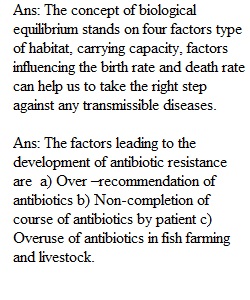


Q 1. How does biological equilibrium relate to public health disease transmission and disease elimination?2. What are some of the key issues in the development of antibiotic resistance? How can we better limit disease resistance?3. Describe/define breakpoint transmission and give a few real-world examples of why this is important in public health.1. Describe the life cycle of malaria in full detail. Indicate where vaccines can make a difference and how relative to transmission reduction and disease reduction2.Describe the clinical syndromes of malaria and the impacts of malaria during pregnancy on the mother, fetus and newborn.3. You are the USAID President’s Malaria Initiative Coordinator in Dar es Salaam. What key control interventions would you recommend? Would you recommend any geographic priorities? How would you best coordinate USAID’s efforts with other malaria donors, the Global Fund and the Government of Tanzania? How would you involve community leaders and community organizations such as churches and mosques4. You are in a meeting with Bill Gates on malaria control in Africa. He explains that the BMG Foundation’s objective is to eradicate malaria worldwide. How would you respond in challenging the wisdom of global malaria eradication versus control?
View Related Questions